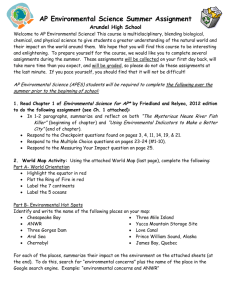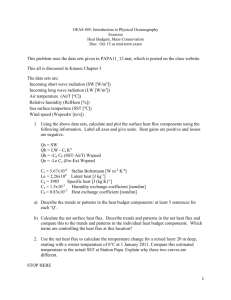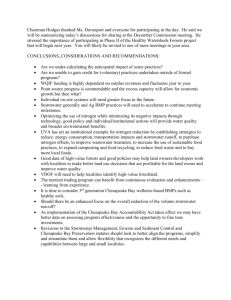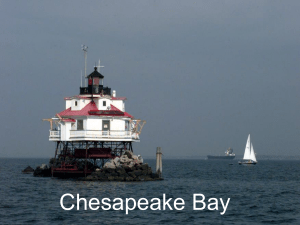LeightonChesapeake Bay Intro
advertisement
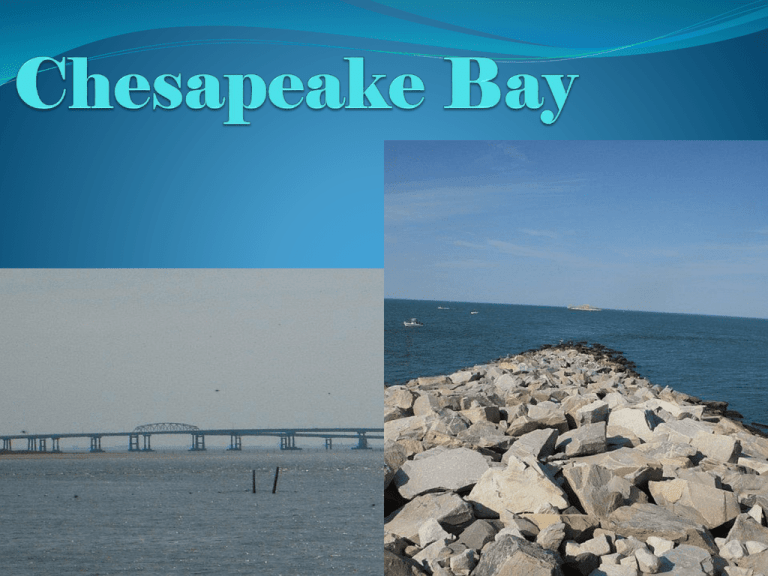
Overfishing and deterioration of their habitat has stressed the blue crab populations throughout much of their range. Callinectes sapidus The Blue Crab is a commonly seen resident of shallow coastal waters Although the species lives below the intertidal zone, dead specimens are periodically found washed in onto the beach where they are usually devoured by the always hungry gulls. How big is the Chesapeake Bay? • 180-200 miles North to South • Shoreline is 4,600 miles long • Average depth is 25-30 feet • The Chesapeake Bay is the nations largest estuary. • 80 % water from Susquehanna, Potomac, James rivers • The Chesapeake Bay runs from Maryland to Virginia the border states are Virginia and Maryland • Watershed is Va., Md., De., Pa., N.Y., and W.Va. • Western shore has the largest rivers • 498,000 acres of wetlands What is this again SALINITY WHAT DO YOU REMEMBER FROM LAST CLASS? SALTINESS - Varies from fresh in the North to salty in the South WHY????????? Salinity is greater at bottom WHY???? b/c of gravity Euryhaline is an organism that is tolerant to salinity changes What’s with these WETLANDS Has 2,700 species of flora and fauna 10 tons of organic matter is grown acre/year such as spartina , asters, hibiscus, and cordgrass Oyster bar communities are the base for many other organisms such are crabs, whelk & eels Half of blue crabs in nation live here Many juvenile marine organisms use wetlands as a nursery ground Includes essential nutrients, detritus, and minerals Side Trip.. I got to go over the bridge! My first time too. I love the wind in my face. I’m on Fisherman’s Island. It’s a wildlife sanctuary….. What they don’t make me do ! WATERSHED They cross county, area of land where state, and national all of the water that boundaries. is under it or In the continental drains off of it goes US, there are 2,110 into the same watersheds; place including Hawaii Alaska, and Puerto Rico, there are Watersheds come 2,267 watersheds in all shapes and sizes. ESTUARY New Jersey Low east-facing cliff Parallels Atlantic Coast New Jersey to Carolinas Separates Hard (PM) Rock from softer, gently sloping(M & T S) rock Site of many waterfalls Landstat photo of the Chesapeake Bay Watershed Name the states that drain in the Chesapeake Bay? New York Pennsylvania Maryland Delaware West Virginia Virginia Section 10.1-2100. Cooperative state-local program. -- A. Healthy state and local economies and a healthy Chesapeake Bay are integrally related; balanced economic development and water quality protection are not mutually exclusive. The protection of the public interest in the Chesapeake Bay, its tributaries, and other state waters and the promotion of the general welfare of the people of the Commonwealth require that: (i) the counties, cities, and towns of Tidewater Virginia incorporate general water quality protection measures into their comprehensive plans, zoning ordinances, and subdivision ordinances; (ii) the counties, cities, and towns of Tidewater Virginia establish programs, in accordance with criteria established by the Commonwealth, that define and protect certain lands, such as WETLANDS, TIDAL WETLANDS, Non-TIDAL hereinafter called Chesapeake Bay Preservation Areas, which if improperly developed may result in substantial damage to the water quality of the Chesapeake Bay and its tributaries; (iii) the Commonwealth make its resources available to local governing bodies by providing financial and technical assistance, policy guidance, and oversight when requested or otherwise required to carry out and enforce the provisions of this chapter; and (iv) all agencies of the Commonwealth exercise their delegated authority in a manner consistent with water quality protection provisions of local comprehensive plans, zoning ordinances, and subdivision ordinances when it has been determined that they comply with the provisions of this chapter. B. Local governments have the initiative for planning and for implementing the provisions of this chapter, and the Commonwealth shall act primarily in a supportive role by providing oversight for local governmental programs, by establishing criteria as required by this chapter, and by providing those resources necessary to carry out and enforce the provisions of this chapter. Section 10.1-2103. Powers and duties of the board. - The Board is responsible for carrying out the purposes and provisions of this chapter and is authorized to: 1. Provide land use and development and water quality protection, even those areas of non-point source pollution, information and assistance to the various levels of local, regional and state government within the Commonwealth. 2. Consult, advise, and coordinate with the Governor, the Secretary, the General Assembly, other state agencies, regional agencies, local governments and federal agencies for the purpose of implementing this chapter. 3. Provide financial and technical assistance and advice to local governments and to regional and state agencies concerning aspects of land use and development and water quality protection pursuant to this chapter. 4. Promulgate regulations pursuant to the Administrative Process Act (§ 9-6.14:1 et seq.). 5. Develop, promulgate and keep current the criteria required by § 10.1-2107. 6. Provide technical assistance and advice or other aid for the development, adoption and implementation of local comprehensive plans, zoning ordinances, subdivision ordinances, and other land use and development and water quality protection measures utilizing criteria established by the Board to carry out the provisions of this chapter, so that LESS rather than more impenetrable surfaces are created. Because increasing the amount of hard surfaces of any lands here in tidewater act to increase the amount of STORM WATER runoff picking up and moving the pollutants on the streets to the nearest water way, the BAY. 7. Develop procedures for use by local governments to designate Chesapeake Bay Preservation Areas in accordance with the criteria developed pursuant to § 10.1-2107. 8. Ensure that local government comprehensive plans, zoning ordinances and subdivision ordinances are in accordance with the provisions of this chapter. Determination of compliance shall be in accordance with the provisions of the Administrative Process Act (§ 9-6.14:1 et seq.). 9. Make application for federal funds that may become available under federal acts and to transmit such funds when applicable to any appropriate person. 10. Take administrative and legal actions to ensure compliance by counties, cities and towns with the provisions of this chapter including the proper enforcement and implementation of, and continual compliance with, this chapter. 11. Perform such other duties and responsibilities related to the use and development of land and the protection of water quality as the Secretary may assign. Summarize How the CBPA Works 1. _________________________________ 2. _________________________________ 3. _________________________________ Therefore the overall goals of the CBPS are to ______& ________________the waters of the BAY from being ________________. 9. Make application for federal funds that may become available under federal acts and to transmit such funds when applicable to any appropriate person. 10. Take administrative and legal actions to ensure compliance by counties, cities and towns with the provisions of this chapter including the proper enforcement and implementation of, and continual compliance with, this chapter. 11. Perform such other duties and responsibilities related to the use and development of land and the protection of water quality as the Secretary may assign. Summarize How the CBPA Works 1. Protect the Bay______________________________ 2. Draw up Regulations _________________________ 3. Enforces local government policies or compliance__ Therefore the overall goals of the CBPS are to PROTECT & PREVENT the waters of the BAY from being POLLUTED. Expanding wetlands are claiming low-lying communities on Smith Island, Md. & Tangier Island, Va. Settlements begun in the 18th & 19th centuries, together with their churches & cemeteries, are often surrounded by the rising water of the bay during periods of extreme high tides -- a prologue to the rising sea level. Extreme high tide at Hooper’s Island, Eastern Shore (1998) Native Americans Settlers African Americans Famous Battles Battle of Hampton Roads Invasive Organisms species animals and plants that are not native to a certain area harm the ecosystem they invade. There are as many as 200 invasive species present in the Chesapeake Bay watershed that are causing some serious issues in an already-stressed ecosystem. Chesapeake Bay Region There are over 200 known or possible invasive species thought to cause serious problems 46 of these were identified in 2001 as nuisance species 6 pose the greatest threat to the Bay region’s ecosystem. 6 living in the Chesapeake Bay watershed are mute swans Nutria CAN BE INTRODUCED IN MANY WAYS Accidental travel by humans or animals phragmites, purple loosestrife water chestnut zebra mussels Trade and Tourism Brought here deliberately (on Purpose) mute swan (Cygnus olor) Mute swans feed almost exclusively on bay grasses: each adult consumes more than 8 pounds daily and pulls whole plants up by the roots or rhizomes. Bay grass restoration efforts have been frequently hindered by feeding mute swans. Nutria (Myocastor coypus) Prolific aquatic rodents Native to South America Dig out and feed on the roots of marsh grasses Substantial wetland losses in Maryland, particularly at the Blackwater National Wildlife Refuge (NWR) on the Eastern Shore. California 1899; fur farming & weed control Nutria - Impact on the Bay “Eat Out” (devoid of vegetation) Eat marsh vegetation Dig under marsh, feed on root BNWR has lost about 8,000 acres to this rodent Olney three-square bulrush, a preferred food choice of nutria Common Reed Phragmites (Phragmites australis) Cut down and or pulled out Set fire to the area if large section needs to be removed No chemical method because of CBPA of nonpollutant materials to kill organisms Native to US Impact: Crowds out native species Purple loosestrife (Lythrum salicaria) Provides little or low-quality food, shelter, nesting sites, nursery grounds, (muskrats and waterfowl ) dominates and reduces native species and spreads rapidly Introduced in 1800’s –ornamental and medicinal uses; dry ballast in ships and dumped by foreign ships along coastlines It just spread by canals, waterways, use of roads, commercial sale for gardens, Water chestnut (Trapa natans) Original use in ornamental ponds reappear several years after eradication efforts Spreads rapidly Forms complete canopy blocking sunlight from reaching bay grasses growing on bottom Thick beds impede navigation Seeds with 4 hard, ½ inch spines sharp enough to cut shoe leather pose a hazard to beach activities Aquatic plant native to Europe, Asia and Africa 1855, Concord, Massachusetts Zebra Mussel (Dreissena polymorpha) •Encrust native mussels and crayfish & attach to buoys, ropes, docks, boat hulls •Biofouling organisms •Reduce the amount of plankton available to native filter feeders •Clumps clog pipes to power plants and water processing for industry and city water treatment facilities • Freshwater bivalve native to Caspian & Black Seas of Europe (Russia) •1988 first seen in Great Lakes region •Came from unconnected waterways via ship bilge, ballast water and anchors or anchor lockers. Invasive Organisms "European green crab" (Carcinus maenas) North and Baltic Seas the shell (carapace) color can vary from dark, mottled green to orange or red, with yellow patches on the dorsal carapace Sacculina carcini – parasite that takes total control of the crab – it doesn’t molt, grow or reproduce for the rest of its life Green crabs have been implicated in the destruction of the soft-shell clam fisheries in New England (Cohen and Carlton 1995) and the reduction of populations of other commercially important bivalves including the scallop, Argopecten irradians, and the northern quahog, Mercenaria mercenaria (Morgan et al. 1980; Walton, unpublished data as cited in Grosholz and Ruiz 2002). In Connecticut, weekly rates of crab predation on scallops were as high as 70% leading Tettlebach (1986) to observe that green crabs were responsible for most observed mortality in scallops and were a limiting factor in population size. Green Crab GREEN CRAB was "one of the worst, if not the worst, calm predators we know." Veined Rapa Whelk Impact: Preys on bivalves, such as oysters and mussels Native to: Pacific Ocean Status: Established in Chesapeake Bay. Adult and egg cases are reported in the lower Chesapeake Bay. Established: James, York and Rappahannock Rivers Common Reed Phragmites (Phragmites australis) Cut down and or pulled out Set fire to the area if large section needs to be removed No chemical method because of CBPA of nonpollutant materials to kill organisms Native to US Impact: Crowds out native species Japanese Oyster (Crassotrea Live for 30 years or more It has been documented destroying habitat and causing eutrophication of the water bodies it invades (NIMPIS 2002) large filtration capacity and filters gigas) Main producer countries of the Japanese Oyster, Crassotrea gigas.
